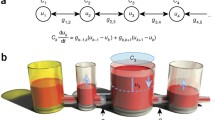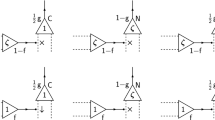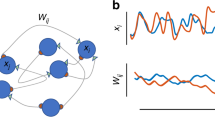Abstract
We define the memory capacity of networks of binary neurons with finite-state synapses in terms of retrieval probabilities of learned patterns under standard asynchronous dynamics with a predetermined threshold. The threshold is set to control the proportion of non-selective neurons that fire. An optimal inhibition level is chosen to stabilize network behavior. For any local learning rule we provide a computationally efficient and highly accurate approximation to the retrieval probability of a pattern as a function of its age. The method is applied to the sequential models (Fusi and Abbott, Nat Neurosci 10:485–493, 2007) and meta-plasticity models (Fusi et al., Neuron 45(4):599–611, 2005; Leibold and Kempter, Cereb Cortex 18:67–77, 2008). We show that as the number of synaptic states increases, the capacity, as defined here, either plateaus or decreases. In the few cases where multi-state models exceed the capacity of binary synapse models the improvement is small.










Similar content being viewed by others
Notes
The fraction of non-selective neurons above the threshold is not specified in the criterion since it has been controlled in the threshold selection. Moreover, because of the strong inhibition, there cannot be many non-selective neurons above threshold throughout the dynamics.
The amount of allowable non-selective neurons above the threshold is not specified in the criterion since it has been controlled in the threshold selection.
References
Abraham, W. C., & Bear, M. F. (1996). Metaplasticity: The plasticity of synaptic plasticity. Trends in Neurosciences, 19(4), 126–130. doi:10.1016/S0166-2236(96)80018-X.
Amit, D. J., & Brunel, N. (1997a). Dynamics of recurrent network of spiking neurons before and following learning. Network, 8, 373–404.
Amit, D. J., & Brunel, N. (1997b). Model of global spontaneous activity and local structured activity during delay periods in the cerebral cortex. Cerebral Cortex, 7, 237–252.
Amit, D. J., & Fusi, S. (1994). Learning in neural networks with material synapses. Neural Computation, 6, 957–982.
Amit, D. J., & Mongillo, G. (2003). Selective delay activity in the cortex: Phenomena and interpretation. Cerebral Cortex, 13, 1139–1150.
Amit, Y., & Huang, Y. (2010). Precise capacity analysis in binary networks with multiple coding level inputs. Neural Computation, 22(3), 660–688. doi:10.1162/neco.2009.02-09-967.
Attwell, D., & Laughlin, S. B. (2001). An energy budget for signaling in the grey matter of the brain. Journal of Cerebral Blood Flow and Metabolism, 21(10), 1133–1145.
Barnes, C. A., McNaughton, B. L., Mizumori, S. J., Leonard, B. W., & Lin, L. H. (1990). Comparison of spatial and temporal characteristics of neuronal activity in sequential stages of hippocampal processing. Progress in Brain Research, 83, 287–300.
Barret, A. B., & van Rossum, M. C. (2008). Optimal learning rules for discrete synapses. PLoS Computational Biology, 4, 1–7.
Ben Dayan Rubin, D. D., & Fusi, S. (2007). Long memory lifetimes require complex synapses and limited sparseness. Frontiers in Computational Neuroscience, 1, 1–14.
Brunel, N. (2003). Dynamics and plasticity of stimulus-selective persistent activity in cortical network models. Cerebral Cortex, 13, 1151–1161.
Curti, E., Mongillo, G., La Camera, G., & Amit, D. J. (2004). Mean-field and capacity in realistic networks of spiking neurons storing sparsely coded random memories. Neural Computation, 16, 2597–2637.
Del Giudice, P., Fusi, S., & Mattia, M. (2003). Modelling the formation of working memory with networks of integrate-and-fire neurons connected by plastic synapses. Journal of Physiology Paris, 97(4–6), 659–681. doi:10.1016/j.jphysparis.2004.01.021.
Fusi, S., & Abbott, L. F. (2007). Limits on the memory storage capacity of bounded synapses. Nature Neuroscience, 10, 485–493.
Fusi, S., Drew, P. J., & Abbott, L. (2005). Cascade models of synaptically stored memories. Neuron, 45(4), 599–611. doi:10.1016/j.neuron.2005.02.001.
Fuster, J. (1995). Memory in the cerebral cortex: An empirical approach to neural networks in the human and nonhuman primate. Cambridge, MA: MIT Press.
Jung, M. W., & McNaughton, B. L. (1993). Spatial selectivity of unit activity in the hippocampal granular layer. Hippocampus, 3(0), 165–182.
Leibold, C., & Kempter, R. (2008). Sparseness constrains the prolongation of memory lifetime via synaptic metaplasticity. Cerebral Cortex 18, 67–77.
Lennie P (2003) The cost of cortical computation. Current Biology, 13(6), 493–497. doi:10.1016/S0960-9822(03)00135-0.
Miyashita, Y., & Hayashi, T. (2000). Neural representation of visual objects: Encoding and top-down activation. Current Opinion in Neurobiology, 10(2), 187–194.
Olshausen, B. A., & Field, D. J. (2004). Sparse coding of sensory inputs. Current Opinion in Neurobiology, 14(4), 481–487. doi:10.1016/j.conb.2004.07.007.
Quiroga, R. Q., Reddy, L., Kreiman, G., Koch, C., & Fried, I. (2005). Invariant visual representation by single neurons in the human brain. Nature, 435, 1102–1107.
Robertson, T., Wright, F. T., & Dykstra, R. L. (1988). Order restricted statistical inference. Wiley.
Rolls, E. T., & Tovee, M. J. (1995). Sparseness of the neuronal representation of stimuli in the primate temporal visual cortex. Journal of Physiology, 73(2), 713–726.
Romani, S., Amit, D., & Amit, Y. (2008). Optimizing one-shot learning with binary synapses. Neural Computation, 20, 1928–1950.
Sato, T., Uchida, G., & Tanifuji, M. (2007). The nature of neuronal clustering in inferotemporal cortex of macaque monkey revealed by optical imaging and extracellular recording. In 34th Ann. meet. of soc. for neuroscience. San Diego, USA.
Wang, X. J. (2001). Synaptic reverberation underlying mnemonic persistent activity. Trends in Neurosciences, 24(8), 455–463. doi:10.1016/S0166-2236(00)01868-3.
Willshaw, D., Buneman, O. P., & Longuet-Higgins, H. (1969). Non-holographic associative memory. Nature (London), 222, 960–962.
Author information
Authors and Affiliations
Corresponding author
Additional information
Action Editor: Mark van Rossum
Supported in part by NSF ITR DMS-0706816.
Electronic Supplementary Material
Below is the link to the electronic supplementary material.
Appendix
Appendix
1.1 A.1 Kronecker product
If A is an m×n matrix and B is a p×q matrix, then the Kronecker product A ⊗ B is the mp×nq block matrix
The Kronecker product is bilinear and associative
-
A ⊗ (B + C) = A ⊗ B + A ⊗ C,
-
(A + B) ⊗ C = A ⊗ C + B ⊗ C,
-
(kA) ⊗ B = A ⊗ (kB) = k(A ⊗ B),
-
(A ⊗ B) ⊗ C = A ⊗ (B ⊗ C),
where A, B and C are matrices and k is a scalar. If A, B, C and D are matrices of such size that one can form the matrix products AC and BD, then
This is called the mixed-product property because it mixes the ordinary matrix product and the Kronecker product.
1.2 A.2 Transition matrices and covariances
As the synaptic modification rule is local, the evolution of the state of a synapse is a Markov chain. Summing over the possible firing states of the pre- and postsynaptic neuron, the probability a synapse transits from α m to α m′ is
so the transition matrix can then be written as
Similarly, a pair of synapses with a common postsynaptic neuron \((J^{(p)}_{ij}, J^{(p)}_{ik})\) is also a Markov chain, where the state space is the cross product {α 1, α 2,...,α M }×{α 1, α 2,...,α M }. Again summing over the firing status of the three neurons i, j, k, the transition probability from (α l ,α m ) to (α l′,α m′) is
so the transition matrix is
Suppose the network is initialized at its stationary state. \(\pi_x^{(0)}=\pi\) and \(\gamma^{(0)}_x=\gamma\). To obtain the mean and variance after the first step of learning (Eq. (6)), given \(\xi^{(1)}_i=x\), since the presynaptic neuron is on \(\xi^{(1)}_j=\xi^{(1)}_k=1\), the transition probability for \(J^{(p)}_{ij}\) from α m to α m′ is \(q^{x1}_{m m'}\), and the transition probability for \((J^{(p)}_{ij}, J^{(p)}_{ik})\) from (α l ,α m ) to (α l′,α m′) is \(q^{x1}_{l l'}q^{x1}_{m m'}\). This explains Eq. (6).
Since \(J^{(p)}_{ij}\) is a indicators variable, \(\mathsf{E}[J^{(p)}_{ij}|\xi^{(1)}_i=x,\xi^{(1)}_j=1]\) and \(\mathsf{E}[J^{(p)}_{ij}\otimes J^{(p)}_{ik}|\xi^{(1)}_i=x,\xi^{(1)}_j=\xi^{(1)}_k=1]\) are exactly the p-step distribution of the Markov chains \(\pi^{(p)}_x\) and \(\gamma^{(p)}_x\), and Eq. (7) comes from the Kolmogorov equations.
Equation (8) is straightforward since \(W^{(p)}_{ij}=J^{(p)}_{ij}\mathbf{w}^T\). One can verify that \(\mathsf{Var}(J^{(p)}_{ij}|\xi^{(1)}_i=x,\xi^{(1)}_j=1)=\mathrm{Diag}(\pi_x^{(p)}) -\pi_x^{(p)}(\pi_x^{(p)})^T\) and deduce Eq. (9), where \(\mathrm{Diag}(\pi_x^{(p)})\) is the diagonal matrix with \(\pi_x^{(p)}\) on the diagonal. To obtain Eq. (10) we use:
where the last equality comes from the mixed-product property of the Kronecker product (See Appendix A.1).
1.3 A.3 Decorrelating the synapses
If the four Q matrices are of the form \(Q^{11}=I_{2m}+q_+D_+\), \(Q^{01}=Q^{10}=I_{2m}+q_-D_-\), \(Q^{00}=I_{2m}+q_0D_+\), where \(q_0=\frac{f^2q_+}{(1-f)^2}\), \(q_-=\frac{\tau f q_+}{1-f}\), then
If π is the stationary distribution of P, i.e. πP = π, then π(D + + τD −) = 0, which implies πP 1 = πP 0 = π. Hence, γ = π ⊗ π of is the stationary distribution of S since
Thus the stationary synaptic covariance ρ defined in Eq. (14) must be 0.
This learning rule only works for single-level coded stimuli, but not for multi-level coded stimuli.
1.4 A.4 Bias in sparseness measurement
In Rolls and Tovee (1995) and Sato et al. (2007) coding level is defined as
where r i is the firing rate of the neuron to the ith stimulus in a set of n stimuli. Say the baseline firing rate of the neuron is r, and if the neuron is selective to the stimulus, the firing rate is Lr (L > 1), and assume the true sparseness is f. Then on average ∑ i r i /n ≈ fLr + (1 − f)r, \(\sum_i r_i^2/n \approx fL^2r^2 + (1-f)r^2\).
Though a→f as L→ ∞, when f→0, a ≈ 1 − f. The relationship between a and f is not monotone and when L = 30, a is always above 0.1 whatever f is (Fig. 11). If the baseline firing rate is subtracted from each r i , then L will be larger and make a closer to f.
The sparseness measure a (Eq. (36)) versus the actual coding level f for L = 10 and 30
Rights and permissions
About this article
Cite this article
Huang, Y., Amit, Y. Capacity analysis in multi-state synaptic models: a retrieval probability perspective. J Comput Neurosci 30, 699–720 (2011). https://doi.org/10.1007/s10827-010-0287-7
Received:
Revised:
Accepted:
Published:
Issue Date:
DOI: https://doi.org/10.1007/s10827-010-0287-7





